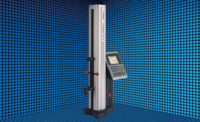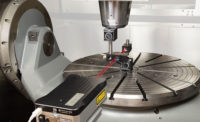Determining a machine tool's capabilities prior to post-process part inspection greatly reduces the potential for scrap, and can eliminate downtime spent searching for sources of errors. This is where a compact and portable tool known as a ballbar can pay significant dividends. A ballbar takes the guesswork out of machine tool evaluation, allowing users to quickly establish a performance level before the machine cuts chips. It can also serve as a valuable diagnostic tool when things go wrong.
Considered by many to be a must-have tool for the machine shop, the ballbar can see every motion affecting error that exists in the axes under test. These errors can include backlash, reversal spikes, lateral play, cyclic error, servo mismatch, scaling errors and geometry errors such as squareness and straightness (see "A Closer Look at Machine Tool Inaccuracies).
Ballbars are used by machine tool manufacturers, end users, service and maintenance companies and resellers for pre-production tests, predictive maintenance programs, new machine prove-out, machine grading and comparison, and machine "check after wreck," when a machine crash has stopped production.
Early error detection with a ballbar permits optimum efficiency in scheduling maintenance and repairs. Ballbar testing is included in a number of standards for machine tool accuracy testing, including ASME B5.54 and ISO 230. Besides isolating errors, the ballbar also allows process optimization. Users can determine what feedrate delivers the best accuracy for a specific cutting procedure -- such as contouring -- through dynamic checking of the machine tool as it is driven at different feedrates.
What's a ballbar?
A ballbar monitors machine tool spindle movement as its follows a programmed circular path, and then compares the test path to that of a perfect circle. The ballbar consists of a telescopic bar with precision-machined magnetic balls and cup joints at either end. The bar houses a high-accuracy position sensor. One end of the ballbar typically mounts via a patented magnetic cup to the machine bed, while the ball at the other end attaches to a magnetic cup in the machine's spindle. The mounting configuration allows the ballbar to transcribe a hemisphere of motion in determining the machine's dynamic positioning accuracy.
The ballbar's internal sensor contains two coils and a moving core, and functions much like a linear variable differential transformer. As the ballbar length changes, the core moves inside the coils and causes a change in coil inductance. This inductance change is detected by sensor circuitry and converted to a position readout with a resolution of 0.1 micron (0.000004 inch) and an accuracy of + or - 0.5 micron ( + or - 0.00002 inch) at 20 C (68 F).
The ballbar has only one wire connection, and plugs directly (or via a USB adapter) into the RS232 port of any Windows-based personal computer with ballbar software installed. Notebook or laptop models provide maximum portability on the shop floor.
A typical ballbar test may sweep a 100 millimeter, or 4 inch, radius, but tests ranging from 50 to more than 1,000 millimeters (2 to 40 inches) are possible. Different lengths may be used to increase sensitivity to particular errors. A longer length may be used to increase sensitivity to geometry errors such as squareness, while a very small radius may be used to highlight dynamic errors such as servo mismatch. A small circle kit is often offered to enable test radii of as little as 15 millimeters (0.59 inch) to be carried out. Other accessories are typically available to enable ballbars to be mounted between the spindle and turret on horizontal lathes and vertical turret lathes.
Ballbar tests typically take just 10 to 15 minutes and can be performed in full-circle or any angle X-Y, X-Z or Y-Z arc traces. After ballbar installation on the machine, the machine is programmed to drive its spindle in a circular path having a radius equal to the length of the ball-bar. The ballbar tracks spindle movement to + or - 0.5 micron (0.00002 inch), weighs errors based on the measured values, and converts the ballbar data into an error-exaggerating polar plot of the machine's true movement.
An experienced user can identify every error in the machine from this plot. But sophisticated algorithms in the ballbar software also produce a comprehensive diagnostic report that enumerates up to 22 different dynamic and geometric error values, and then ranks them in order of importance. The overall positioning capability, or true position, of the machine is also calculated. Reports may also be produced in accordance with ISO, ASME or JIS standards.
One "hip" ballbar user
Machine tool users in a variety of industries are cashing in on the advantages provided by ballbar techniques.
One is Smith & Nephew Orthopedics (Memphis, TN) a maker of medical implants. The company believes that its machine tools must be as flexible as the replacement hips, knees and shoulders it produces.
Smith & Nephew finds that all 325 machines tools that it uses to create implants must be capable of producing precision parts to Six Sigma. To keep its machines capable of producing tight-tolerance work in such variable production, the company regularly tests machine performance with a ballbar.
When Richard Grimes, calibration specialist, was put in charge of the company's computer numerical control (CNC) testing, repair and validation program in February, 1998, the performance of the plant's most critical machine categories was unacceptable; some machines were rated at only 3 Sigma. This caused much rework and scrap.
Since Grimes' implemented ballbar diagnosis, the plant's machine tools are now operating at true Six Sigma, or 0.0003% failure rate. "We now make better products and have less down time because we can catch problems before they happen," says Grimes.
In all, Grimes uses the ballbar to check 13 performance parameters. The company's quality department determined that those 13 items combined must not be off by more than + or - 0.003 inch. "When new equipment comes in, I first test the machine with the ballbar," Grimes explains. "If a machine is moved, crashes or loses a spindle, I run a ballbar test. Regardless, each ma-chine gets an annual test and will not run until it meets or exceeds our established spec."
This regimen of periodic ballbar checkups and record keeping allows Grimes to keep his huge army of CNC machines tools fit and flexible -- helping to ensure that Smith & Nephew implants fit precisely and function flawlessly.
Keep it tight
Another heavy ballbar user is Hamilton-Sundstrand -- a manufacturer of aerospace fuel handling systems, auxiliary power units (APUs) and wing flap actuation systems. The company relies on ballbar calibration to ensure that its machines, both old and new, can "cut it" on tight-tolerance parts. While a machine tool may be designed and built to maintain a particular tolerance, wear and temperature changes will affect its capability to maintain factory specs, the company found.
Hamilton-Sunstrand's Grand Junction, CO, plant specializes in the machining of extremely tight-toleranced housings, forgings and hog-outs. Most parts have complex geometries that require four- and five-axis CNC equipment to produce typical aerospace tolerances of 0.001-inch true position, + or - 0.0005- inch diameter, and surface profile of 0.002 inch.
Personnel regularly monitor all of the company's CNC machine tools' performance parameters with quick ballbar tests. At the first sign of any nonconformance in parts, the machinist sets up and conducts a ballbar diagnostic test. The test checks 14 different geometric parameters in each of the three machine planes tested -- X-Y, X-Z and Y-Z. Errors are quickly identified, then corrected by maintenance personnel.
Additionally, periodic ballbar checks help reduce unscheduled downtime by tracking trends in machine performance. Problems can be identified before a machine tool goes down, allowing for scheduled repairs, rather than production crises.
The ballbar has also helped reduce the time needed to complete routine preventive maintenance. Ballbar data allows the maintenance technician to determine the true extent of any corrective action a machine may need. In many cases, the machine requires fewer adjustments than normally scheduled.
TECH TIPS
- A ballbar monitors machine tool spindle movement as its follows a programmed circular path, and then compares the test path to that of a perfect circle.
- Software converts the ballbar data into an error-exaggerating polar plot of the machine's true movement, and also produces a comprehensive diagnostic report that enumerates and ranks errors in their order of importance.
- Ballbars are used by machine tool manufacturers, end users, service and maintenance companies and resellers for preproduction tests, predictive maintenance programs, new machine prove-out, machine grading and comparison, and machine "check after wreck."
A closer look at machine tool inaccuracies
Ballbar calibration can reveal a number of machine tool problems. Here is a list of common errors found through ballbar testing and shown on exaggerated ballbar plots:
- Axis reversal spikes. When an axis is driven in one direction and then has to reverse and move in the opposite direction, instead of reversing smoothly, it may pause momentarily at the turnaround point. This appears as short spikes that appear on either axis reversal point.
- Scale mismatch is shown as an oval plot, extended along one axis. One of the machine axes is either over traveling or under traveling relative to the other. One axis could be feeding too far, or the other is not feeding far enough, possibly because of overheating or a faulty ballscrew.
- Backlash step, shown as a step along one axis, indicates lost motion from backlash. An outward step could suggest play in the drive system, while an inward step may indicate hysteresis in the CNC encoder. Either step type could be caused by play in the machine guideways.
- Stick-slip noise results when friction causes one axis to stick when it is fed at a very low rate. Left unchecked, this error could prevent the machine from producing an acceptable surface finish.
- Squareness error is shown in an oval ballbar plot, and occurs when normally orthogonal axes are no longer moving at 90 degrees, relative to one another. This may be because of a bent axis or some other misalignment. This squareness error oval "tilts" 45 degrees with respect to the two axes, and remains in the same position regardless of the direction of travel of the ballbar (CW or CCW).
- Servo mismatch is shown as an oval plot tilted by 45 degrees that does not stay in place; it shifts back and forth by 90 degrees depending on the direction of travel. This indicates mismatched servo gains in the CNC, causing the axis with the higher gain to lead the other, and making a precise circular interpolation impossible.
- Cyclic error is shown as a plot with waviness that varies in amplitude and reaches maximum amplitude at axis reversal. This error is caused by a flaw in the axis leadscrew or leadscrew mounting.
- Master/slave changeover error often results on CNCs that can only interpolate one axis at a time. Varying the speed of the master axis while the slave axis follows can generate arcs. This changeover error produces a plot with 45-degree steps, and may make precision machining of circular features impossible.

